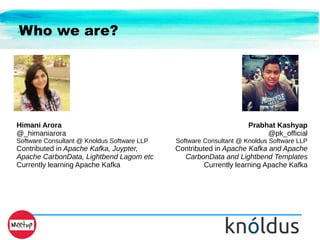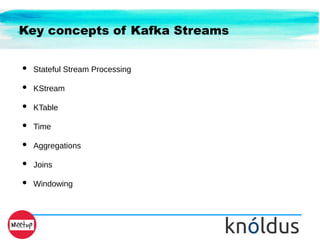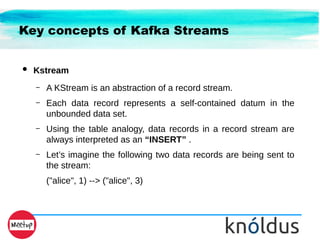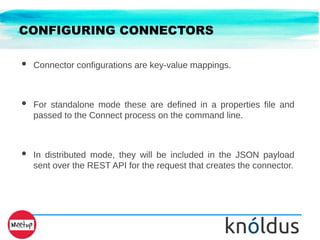Stream processing using Kafka
- 1. Himani Arora & Prabhat Kashyap Software Consultant @_himaniarora @pk_official
- 2. Who we are? Himani Arora @_himaniarora Software Consultant @ Knoldus Software LLP Contributed in Apache Kafka, Juypter, Apache CarbonData, Lightbend Lagom etc Currently learning Apache Kafka Prabhat Kashyap @pk_official Software Consultant @ Knoldus Software LLP Contributed in Apache Kafka and Apache CarbonData and Lightbend Templates Currently learning Apache Kafka
- 3. Agenda ● What is Stream processing ● Paradigms of programming ● Stream Processing with Kafka ● What are Kafka Streams ● Inside Kafka Streams ● Demonstration of stream processing using Kafka Streams ● Overview of Kafka Connect ● Demo with Kafka Connect
- 4. What is stream processing? ● Real-time processing of data ● Does not treat data as static tables or files ● Data has to be processed fast, so that a firm can react to changing business conditions in real time. This is required for trading, fraud detection, system monitoring, and many other examples. ● A “too late architecture” cannot realize these use cases.
- 5. BIG DATA VERSUS FAST DATA
- 6. 3 PARADIGMS OF PROGRAMMING ● REQUEST/RESPONSE ● BATCH SYSTEMS ● STREAM PROCESSING
- 8. BATCH SYSTEM
- 10. STREAM PROCESSING with KAFKA 2 APPROACHES: ● DO IT YOURSELF (DIY ! ) STREAM PROCESSING ● STREAM PROCESSING FRAMEWORK
- 11. DIY STREAM PROCESSING Major Challenges: ● FAULT TOLERANCE ● PARTITIONING AND SCALABILITY ● TIME ● STATE ● REPROCESSING
- 12. STREAM PROCESSING FRAMEWORK Many already available stream processing framework are: SPARK STORM SAMZA FLINK ETC...
- 13. KAFKA STREAMS : ANOTHER WAY OF STREAM PROCESSING
- 14. Let’s starts with Kafka Stream but wait.. What is KAFKA?
- 15. Hello! Apache Kafka ● Apache Kafka is an Open Source project under Apache Licence 2.0 ● Apache Kafka was originally developed by LinkedIn. ● On 23 October 2012 Apache Kafka graduated from incubator to top level projects. ● Components of Apache Kafka ○ Producer ○ Consumer ○ Broker ○ Topic ○ Data ○ Parallelism
- 17. Enterprises that use Kafka
- 18. What is Kafka Streams ● It is Streams API of Apache Kafka, available through a Java library. ● Kafka Streams is built on top of functionality provided by Kafka’s. ● It is , by deliberate design, tightly integrated with Apache Kafka. ● It can be used to build highly scalable, elastic, fault-tolerant, distributed applications and microservices. ● Kafka Streams API allows you to create real-time applications. ● It is the easiest yet the most powerful technology to process data stored in Kafka.
- 20. If we look closer ● A key motivation of the Kafka Streams API is to bring stream processing out of the Big Data niche into the world of mainstream application development. ● Using the Kafka Streams API you can implement standard Java applications to solve your stream processing needs. ● Your applications are fully elastic: you can run one or more instances of your application. ● This lightweight and integrative approach of the Kafka Streams API – “Build applications, not infrastructure!” . ● Deployment-wise you are free to chose from any technology that can deploy Java applications
- 21. Capabilities of Kafka Stream ● Powerful ○ Makes your applications highly scalable, elastic, distributed, fault- tolerant. ○ Stateful and stateless processing ○ Event-time processing with windowing, joins, aggregations ● Lightweight ○ Low barrier to entry ○ No processing cluster required ○ No external dependencies other than Apache Kafka
- 22. Capabilities of Kafka Stream ● Real-time ○ Millisecond processing latency ○ Record-at-a-time processing (no micro-batching) ○ Seamlessly handles late-arriving and out-of-order data ○ High throughput ● Fully integrated ○ 100% compatible with Apache Kafka 0.10.2 and 0.10.1 ○ Easy to integrate into existing applications and microservices ○ Runs everywhere: on-premises, public clouds, private clouds, containers, etc. ○ Integrates with databases through continous change data capture (CDC) performed by Kafka Connect
- 23. Key concepts of Kafka Streams ● Stateful Stream Processing ● KStream ● KTable ● Time ● Aggregations ● Joins ● Windowing
- 24. Key concepts of Kafka Streams ● Stateful Stream Processing – Some stream processing applications don’t require state – they are stateless. – In practice, however, most applications require state – they are stateful. – The state must be managed in a fault-tolerant manner. – Application is stateful whenever, for example, it needs to join, aggregate, or window its input data.
- 25. Key concepts of Kafka Streams ● Kstream – A KStream is an abstraction of a record stream. – Each data record represents a self-contained datum in the unbounded data set. – Using the table analogy, data records in a record stream are always interpreted as an “INSERT” . – Let’s imagine the following two data records are being sent to the stream: ("alice", 1) --> ("alice", 3)
- 26. Key concepts of Kafka Streams ● Ktable – A KStream is an abstraction of a changelog stream. – Each data record represents an update. – Using the table analogy, data records in a record stream are always interpreted as an “UPDATE” . – Let’s imagine the following two data records are being sent to the stream: ("alice", 1) --> ("alice", 3)
- 27. Key concepts of Kafka Streams ● Time – A critical aspect in stream processing is the the notion of time. – Kafka Streams supports the following notions of time: ● Event Time ● Processing Time ● Ingestion Time – Kafka Streams assigns a timestamp to every data record via so-called timestamp extractors.
- 28. Key concepts of Kafka Streams ● Aggregations – An aggregation operation takes one input stream or table, and yields a new table. – It is done by combining multiple input records into a single output record. – In the Kafka Streams DSL, an input stream of an aggregation operation can be a KStream or a KTable, but the output stream will always be a KTable.
- 29. Key concepts of Kafka Streams ● Joins – A join operation merges two input streams and/or tables based on the keys of their data records, and yields a new stream/table.
- 30. Key concepts of Kafka Streams ● Windowing – Windowing lets you control how to group records that have the same key for stateful operations such as aggregations or joins into so- called windows. – Windows are tracked per record key. – When working with windows, you can specify a retention period for the window. – This retention period controls how long Kafka Streams will wait for out-of-order or late-arriving data records for a given window. – If a record arrives after the retention period of a window has passed, the record is discarded and will not be processed in that window.
- 33. Stream Partitions and Tasks ● Each stream partition is a totally ordered sequence of data records and maps to a Kafka topic partition. ● A data record in the stream maps to a Kafka message from that topic. ● The keys of data records determine the partitioning of data in both Kafka and Kafka Streams, i.e., how data is routed to specific partitions within topics.
- 34. Threading Model ● Kafka Streams allows the user to configure the number of threads that the library can use to parallelize processing within an application instance. ● Each thread can execute one or more stream tasks with their processor topologies independently.
- 35. State ● Kafka Streams provides so-called state stores. ● State can be used by stream processing applications to store and query data, which is an important capability when implementing stateful operations.
- 36. Backpressure ● Kafka Streams does not use a backpressure mechanism because it does not need one. ● It uses depth-first processing strategy. ● Each record consumed from Kafka will go through the whole processor (sub-)topology for processing and for (possibly) being written back to Kafka before the next record will be processed. ● No records are being buffered in-memory between two connected stream processors. ● Kafka Streams leverages Kafka’s consumer client behind the scenes.
- 38. HOW TO GET DATA IN AND OUT OF KAFKA?
- 39. KAFKA CONNECT
- 40. Kafka connect ● So-called Sources import data into Kafka, and Sinks export data from Kafka. ● An implementation of a Source or Sink is a Connector. And users deploy connectors to enable data flows on Kafka ● All Kafka Connect sources and sinks map to partitioned streams of records. ● This is a generalization of Kafka’s concept of topic partitions: a stream refers to the complete set of records that are split into independent infinite sequences of records
- 41. CONFIGURING CONNECTORS ● Connector configurations are key-value mappings. ● For standalone mode these are defined in a properties file and passed to the Connect process on the command line. ● In distributed mode, they will be included in the JSON payload sent over the REST API for the request that creates the connector.
- 42. CONFIGURING CONNECTORS Few settings common that are common to all connectors: ● name - Unique name for the connector. Attempting to register again with the same name will fail. ● connector.class - The Java class for the connector ● tasks.max - The maximum number of tasks that should be created for this connector. The connector may create fewer tasks if it cannot achieve this level of parallelism.
- 44. Thank You
Editor's Notes
- #5: continuously, concurrently, and in a record-by-record fashion. But as a continuous infinite stream of data integrated from both live and historical sources.
- #6: A big data architecture contains several parts. Often, masses of structured and semi-structured historical data are stored in Hadoop (Volume + Variety). On the other side, stream processing is used for fast data requirements (Velocity + Variety). Both complement each other very well. This meetup focuses on real-time and stream processing.
- #8: IMAGE SOURCE https://image.slidesharecdn.com/demystifyingstreamprocessingwithapachekafka-161118053223/95/demystifying-stream-processing-with-apache-kafka-4-638.jpg?cb=1479447621 Synchronous and tightly coupled Scaling is possible by adding more instances to this service Latency sensitive and due to tight coupling its sensitive to failures.
- #9: you send all your inputs in and wait for your system to crunch all that data before it send all the output back.
- #10: in between request/response and batch systems. here you send some inputs in and you get some outputs back. this definition of SOME is left to the program. the o/p is available at variable times too. the BIG shift is that, stream processing knows that the data is unbounded and it shall never be complete. BENEFIT: It gives complete control to the program over the tradeoffs involved. (latency, correctness and cost )
- #11: DIY → you take your kafka libraries and you decide to decide to do everything yourself. If you have decided to do this then you should be aware of these hard problems.
- #16: producers publish data to Kafka brokers, and consumers read published data from Kafka brokers. Producers and consumers are totally decoupled, and both run outside the Kafka brokers in the perimeter of a Kafka cluster. A Kafka cluster consists of one or more brokers.
- #17: Kafka topics are divided into a number of partitions. Partitions allow you to parallelize a topic by splitting the data in a particular topic across multiple brokers — each partition can be placed on a separate machine to allow for multiple consumers to read from a topic in parallel. Consumers can also be parallelized so that multiple consumers can read from multiple partitions in a topic allowing for very high message processing throughput.
- #41: Kafka Connect is a tool for scalably and reliably streaming data between Apache Kafka and other data systems. It makes it simple to quickly define connectors that move large data sets into and out of Kafka. Kafka Connect’s scope is narrow: it focuses only on copying streaming data to and from Kafka and does not handle other tasks, such as stream processing,
- #42: Standalone: bin/connect-standalone worker.properties connector1.properties [connector2.properties connector3.properties ...] Standalone mode is the simplest mode, where a single process is responsible for executing all connectors and tasks. Since it is a single process, it requires minimal configuration. Distributed mode provides scalability and automatic fault tolerance for Kafka Connect. In distributed mode, you start many worker processes using the same group.id and they automatically coordinate to schedule execution of connectors and tasks across all available workers. curl -X POST -H "Content-Type: application/json" --data '{"name": "local-console-source", "config": {"connector.class":"org.apache.kafka.connect.file.FileStreamSourceConnector", "tasks.max":"1", "topic":"connect-test" }}' http://localhost:8083/connectors # Or, to use a file containing the JSON-formatted configuration # curl -X POST -H "Content-Type: application/json" --data @config.json http://localhost:8083/connectors
- #43: Sink connectors also have one additional option to control their input, topics - A list of topics to use as input for this connector












































